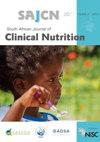Probiotic effect and dietary correlations on faecal microbiota profiles in irritable bowel syndrome
IF 0.8
Q4 NUTRITION & DIETETICS
引用次数: 3
Abstract
Objective: Probiotics and nutrient intakes modulate gastrointestinal (GIT) microbiota and symptoms of irritable bowel syndrome (IBS). The extent to which these factors influence the microbiota is relatively unknown. The primary objective of this paper was to investigate the effect of a probiotic on gut microbiota and IBS symptoms. The secondary objective was exploring correlations between dietary intake and gut microbiota. Design: This study was an extension of a randomised clinical trial (Clinical Trials Registry NCT018867810). Dietary intake was recorded by three-day estimated food records. Faecal samples were collected at three time points: (1) baseline (A), (2) after eight weeks’ probiotic supplementation (Lactobacillus plantarum 299v) (B) and (3) following a two-week washout period (C). Total Bacteroides spp., Bifidobacteria bifidum and Lactobacillus plantarum were quantified by quantitative real-time polymerase chain reaction (qPCR). Results: Twenty-eight diarrhoea-predominant IBS (D-IBS) and 24 constipation-predominant IBS (C-IBS) patients participated. Lactobacillus plantarum profiles at baseline (A) were significantly different between C-IBS and D-IBS (−0.956 ± 1.239 vs. −1.700 ± 1.239; p = 0.024). There was no significant change in bacterial counts after completion of the trial (B) and following the washout period (C) between groups. In both groups there were significant direct correlations between fibre and Lactobacillus plantarum and inverse correlations between fibre and Bacteroides spp. There was no difference in symptom severity scores between treatment and placebo groups during the study. Conclusion: The probiotic had no effect on symptoms and GIT microbiota. Certain nutrients strongly correlate to certain bacterial profiles, suggesting that nutrients can significantly influence gastrointestinal microbiota composition.肠道易激综合征中益生菌效应和饮食对粪便微生物群的相关性
目的:益生菌和营养摄入调节胃肠道(GIT)微生物群和肠易激综合征(IBS)症状。这些因素对微生物群的影响程度相对未知。本文的主要目的是研究益生菌对肠道微生物群和肠易激综合征症状的影响。次要目标是探索饮食摄入与肠道微生物群之间的相关性。设计:本研究是一项随机临床试验(临床试验注册中心NCT018867810)的延伸。膳食摄入量记录为三天的估计食物记录。在三个时间点收集粪便样本:(1)基线(A),(2)补充益生菌8周后(植物乳杆菌299v) (B)和(3)两周清洗期后(C)。通过定量实时聚合酶链反应(qPCR)对总拟杆菌、两歧双歧杆菌和植物乳杆菌进行定量。结果:28例腹泻型IBS (D-IBS)和24例便秘型IBS (C-IBS)患者参与了研究。C-IBS和D-IBS的植物乳杆菌基线谱(A)差异显著(- 0.956±1.239 vs - 1.700±1.239;p = 0.024)。在试验结束(B)和洗脱期(C)之后,两组之间的细菌计数没有显著变化。在两组中,纤维和植物乳杆菌之间存在显著的直接相关,纤维和拟杆菌之间存在负相关。在研究期间,治疗组和安慰剂组在症状严重程度评分上没有差异。结论:益生菌对胃肠道症状及胃肠道菌群无明显影响。某些营养物质与某些细菌特征密切相关,这表明营养物质可以显著影响胃肠道微生物群的组成。
本文章由计算机程序翻译,如有差异,请以英文原文为准。
求助全文
约1分钟内获得全文
求助全文
来源期刊

South African Journal of Clinical Nutrition
NUTRITION & DIETETICS-
CiteScore
2.50
自引率
9.10%
发文量
21
期刊介绍:
1.The Journal accepts articles from all basic and applied areas of dietetics and human nutrition, including clinical nutrition, community nutrition, food science, food policy, food service management, nutrition policy and public health nutrition. 2.The Journal has a broad interpretation of the field of nutrition and recognizes that there are many factors that determine nutritional status and that need to be the subject of scientific investigation and reported in the Journal. 3.The Journal seeks to serve a broad readership and to provide information that will be useful to the scientific community, the academic community, government and non-government stakeholders in the nutrition field, policy makers and industry.
 求助内容:
求助内容: 应助结果提醒方式:
应助结果提醒方式:


